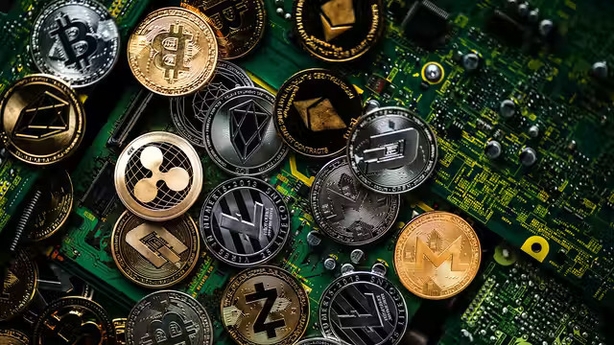Having once been seen by “serious” investors as somewhat of a financial freakshow, cryptocurrencies have recently become more of a ‘must-have’ of mainstream investment.
Standard Chartered, BNY Mellon and Morgan Stanley are among the big names to have invested in crypto-focused firms. Many more have given their backing to start-ups focused on blockchain; the underlying technology that has applications beyond Bitcoin.
The move towards crypto has been fuelled in part by the pandemic, as government stimulus and cheap debt emboldened investors to experiment in search of big returns.
And something similar happened at consumer level, with pandemic lockdowns giving many consumers spare time and spare cash, just as a glut of apps made crypto trading as easy as ordering a takeaway.
A recent survey by cryptocurrency exchange Gemini declared Irish people to be the most ‘crypto-curious’ people in the world.
It claimed that 18% of Irish people currently own, or had previously owned, cryptocurrency. Meanwhile 58% of those with no skin in the game were interested in learning more – or investing themselves – in the next year.
“I’ve been involved in one sense or another in a legal sense since 2013, when it did feel fairly underground, but nowadays by comparison it’s a different world,” said Andrew Tzialli, head of the Blockchain and Crypto group at law firm Philip Lee. “I think now everyone I know, particularly under 50, seems to hold some.
“On a corporate level, we’re seeing bigger players, traditional funds having an interest in the sector – those that you wouldn’t traditionally associate with it.”
And those that did get on board in the recent past might have been forgiven for thinking they had struck digital gold.
Having sat at less than €5,000 at the onset of the pandemic in March 2020, one bitcoin would have set you back more than €50,000 a year later.
Given its flag-bearer status for the cryptocurrency movement, this helped to push up others in the space too.
Having cost less than €600 in late December 2020, Ethereum had broken the €4,000 barrier just under a year later.
Even Dogecoin, a coin established on the back of a then popular meme, enjoyed a brief moment in the sun – thanks in no small part to the support of Elon Musk.
Cryptoreality

But in more recent weeks, recent converts to crypto have been given a rude awakening about its reliability.
Having peaked at almost €60,000 in November, Bitcoin quickly found itself on a negative footing, shedding almost a third of its value by January – and more than half of its peak value by last week.
“We’ve seen a big decline in the price of a lot of cryptocurrencies, including the likes of Ethereum – which shed more than 20% in 24 hours – and then some of the lesser-known ones dropping almost 100%,” said Victoria Scholar, head of investment at Interactive Investor.
“Clearly there’s a lot of volatility and a lot of turmoil within the crypto complex.”
Many of the reasons for this collapse in price may be familiar, or at least understandable, to even casual investors. Though the speed of the decline will have taken many by surprise.
Having hit an all-time high in November, it appears as though many bitcoin backers did what often happens when any asset price breaks a new record – they cashed out.
Bitcoin and other cryptocurrencies also fell prey to the same market fears that has led to a decline in the value of major shares and stock markets in the past 6 months – particularly in tech.
Rapidly rising inflation has prompted central banks to start pulling stimulus and raising interest rates at a faster-than-expected pace. It’s also taken some disposable income out of consumers’ pockets, which all means there is a growing fear of recession, and less appetite for riskier bets.
“It feels as though a lot of it has been driven by this risk-off sentiment,” said Victoria. “We’ve seen investors move away from riskier assets – the like of tech stocks and cryptocurrencies – amid fears about inflation and rising interest rates in the United States.
“All of this pointing towards a concerning economic outlook, again meaning investors are moving away from riskier assets. And we’ve had the geopolitical instability stemming from Russia’s invasion of Ukraine, which has rattled stock markets and dragged crypto down with them.”
But while the initial retreat can be blamed on relatively normal market dynamics, the sharp decline of more recent weeks has a crypto-specific cause.
Luna crater

While Bitcoin is the king of cryptocurrencies, there have been countless alternatives launched on its coat-tails.
Some have established a solid reputation in their own right, while some have crashed and burned – often with cries of foul play following close behind.
Others, meanwhile, have tried to take a different approach to their formulation. That includes Terra and its crypto-sibling, Luna.
Part of its selling point was Terra’s ‘stable coin’ status, which saw its value pegged algorithmically to a more traditional asset – for example the US dollar – as a way of ironing out price volatility.
But earlier this month Terra broke its peg with the dollar, undermining its promise of stability.
The reasons for the split appear to have been an en mass withdrawal of deposits from the in-built mechanism that helped manage its value – likely prompted by the same market realities that saw Bitcoin’s initial price drop earlier in the year.
What it meant for holders of Luna was a complete wipe-out.
Having peaked at €106.42 in April, the value of Luna collapsed from €78.35 on 6 May to a fraction of a cent a week later. An estimated $45 billion worth of market capitalisation was wiped out in the process.
And while Bitcoin’s slump was partially to blame, Luna’s collapse in turn added to the broader concern around crypto values.
In the week it took for Luna to hit zero, Bitcoin’s (already deflated) value fell by a further quarter. Ethereum – another leading crypto – shed nearly 40% of its value (it’s now down about 60% from its December peak). Other stablecoins fared even worse, with many other fringe cryptos also getting wiped out entirely.
Data compiled by Bloomberg estimated that a basket of 25, US-listed cryptos had shed $200 billion of its value in the wake of the Luna debacle.
Crypto-focused discussions on sites like Reddit – which were normally home to (often anonymous) hype and crypto memes – suddenly filled up with stories from people who had lost everything, alongside messages of support and numbers for suicide prevention helplines.
Dark side of the moon

The sudden collapse of some cryptos – and the dramatic declines of others – is sure to have blind-sided many newcomers who had, until then, only experienced the upside.
“Crypto was very much in favour during the pandemic when people were staying at home, looking for investments online – but this crash that we’ve seen has certainly seen a major impact to market sentiment,” said Victoria. “We’ve seen a lot of investors and traders pull out of the market amid fears of further falls.
“Coinbase, a listed crypto exchange, didn’t help either because it said that users may lose their crypto if the exchange were to go under – so that’s also been dampening sentiment as well.”
But to veterans of the standard, this was nothing new.
Many cryptocurrencies have arrived on the scene over the years, promising to be the next big thing before fizzling or crashing out.
Bitcoin itself has also gone through many boom and bust cycles in its relatively brief history.
Between March and December 2017 its value rose by around 188% to €16,722. In the following year its value fell back by 83% to around €2,715.
Just over six months later the price had once again broken through the €10,000 barrier. It then spent the following nine months tumbling back below €5,000.
“Ultimately what this recent price action has done, is to serve as a reminder that, while investors can make massive gains in this market, they can end up nursing heavy losses – so it’s not necessarily for the feint-hearted,” said Victoria.
Bitcoin advocates are confident that this latest slump is just another blip in the crypto’s growth journey. They say that this kind of volatility is part of the experience and point out that, each time it falls, it ultimately comes back stronger.
“People that are hardened to the volatility in markets would have seen these ups and downs 30 times previously,” said Andrew Tzialli. “Unfortunately the one thing the market hasn’t been able to drive out is the volatility – it has happened I don’t know how many times in the past few years, it was just the scale of it that was different.”
Supporters also point to the ecosystem that has built up around crypto, with swathes of new start-ups and innovation coming on stream each month.
“When you see all of these companies who have issued all these tokens and, on paper, they’re worth millions and billions, a lot of them are start-ups,” said Andrew Tzialli. “One thing that’s unique with crypto which you don’t get with traditional start-ups is that, most start-ups aren’t listed on a market; you don’t tend to list on a traditional FTSE or Nasdaq until you’re a huge, multi-million or billion dollar firm.
“So we’re looking at all these start-ups and seeing their volatility – but most start-ups have that volatility. And shrewd investors are looking at this that they’re not buying tokens, they’re buying equity.”
Few are predicting that this slump marks the beginning of the end of crypto – but even fewer are willing to say where the bottom will be, or just how big any rebound might get.
“A lot of investors think that Bitcoin and Ether and others will ultimately reach a bottom and stage a turnaround – the real question is ‘when’, rather than ‘if’,” said Victoria. “But of course nothing is guaranteed; ultimately there are so many different cryptocurrencies – not all of them are likely to survive.
“Some could go on to have value long-term, but some are likely to not.”
And while many still believe in the potential of crypto, its recent stumble may have undone a lot of the progress achieved during its two-year rally.
Mined yourself

The difference this time for Bitcoin, and other cryptocurrencies, is that this collapse has come on a much bigger stage than before. Given the scale of the Wall Street and High Street investment in recent years, more people than ever have been paying attention to what is happening to its price.
As a result, many more will have gotten first-hand experience of the downsides of crypto than would have been the case in 2018. Meanwhile the sizable number of ‘crypto-curious’ people in this country are likely to have had their interest softened by the realisation that gains are not guaranteed.
Where in the past crypto struggled to gain much attention from ‘normal people’, now it has plenty of it – and has to fight to ensure that doesn’t backfire. It also has to deal with the outright hostility of the many who have now been badly burned by their experience.
“With inflation and the cost of living crisis, many have less disposable income left at the end of the month for investing anyway,” said Victoria. “Plus, post-pandemic, a lot of us have less time at home doing nothing, so perhaps less time to be looking up investment markets than we did in 2020.”
The result is a new set of hurdles for crypto to overcome as it tries to achieve the kind of mainstream acceptance that will push it to greater heights and, perhaps, a less volatile existence.
And the market’s slump has also drawn renewed focus on its old hurdles – particularly questions around the actual function of cryptocurrencies, which few seemed bothered about when prices were rising.
It has previously been suggested that the likes of Bitcoin could act as a safe haven asset – a place where investors could retreat when stock markets began to decline.
That theory showed some initial promise in the early stages of the pandemic, when Bitcoin rallied just as major markets braced for a new financial crisis.
But in the end global stimulus and supports led stocks to a rally of their own (albeit a less dramatic one than Bitcoin), while recent events have shown that cryptocurrencies are just as susceptible to mainstream economic fears as the Nasdaq or ISEQ.
“We’ve seen the contagion move from stock markets to cryptocurrencies,” said Victoria. “There was a lot of talk about whether crypto was an inflation hedge or a way to hedge against a downturn, but what we’ve learned is that it’s actually highly correlated with risky stocks – particularly in the Nasdaq.”
And while the number of vendors accepting crypto as payment has been steadily growing, its use as an actual currency remains fairly niche.
Indeed, anyone holding the likes of Bitcoin in recent years would have felt foolish giving away a rapidly appreciating asset in favour of something more consistent like euros or dollars.
But the recent volatility may make retailers or service providers think twice about accepting crypto as payment – as they will now fear getting short-changed by a falling market.
El Salvador’s government, which last year adopted Bitcoin as a legal tender, invested a reported $100m in the standard, and encouraged citizens to invest too, is now sitting on a massive paper loss as a result of its policy.
And then there’s the standard’s growing environmental issue – with the processing power required to mine new Bitcoin leading to astronomical emissions.
A 2019 study in scientific journal Joule estimated that Bitcoin production was creating 22-23 million metric tonnes of carbon dioxide emissions each year – exacerbated by huge server farms in coal-reliant countries.
That’s more than most countries – and is about twice the amount of emissions reductions Ireland is aiming for between 2019 and 2030.
All of this together means that Bitcoin and its crypto cousins face pretty much the same legitimate questions and concerns that they did a decade ago.
If anything doubts about its real-world worth are bigger than ever.
“I think it’s still very, very new – I forget sometimes because I’ve been surrounded by it for so long that it’s still a technology in its infancy,” said Andrew Tzialli. “It was initially about ‘how can crypto replace money?’, then it was about decentralised finance and how that can replace the traditional offering of banks, then it was NFTs.
“All of these sub-technologies within a new technology are still growing and I think it’s still early days and very new in terms of its adoption. The people we’re talking to, investors we’re talking to and a number of the companies we’re working with are still hugely optimistic about the benefits of this technology in the long-term.
There’s no denying that Blockchain, the underlying infrastructure of cryptocurrencies, is still generating a lot of buzz in technology and finance spaces. Supporters say there are now 62 Blockchain ‘unicorns’ around the world, with the amount of investment flowing into the category growing rapidly.
But for cryptocurrency itself, it now has an even greater body of work to do if it ever wants to shake off its ‘risky’ image and be a part of normal consumers’ every-day digital lives.
!function (f, b, e, v, n, t, s) {
if (f.fbq) return;
n = f.fbq = function () {
n.callMethod ? n.callMethod.apply(n, arguments) : n.queue.push(arguments)
}
;
if (!f._fbq) f._fbq = n;
n.push = n;
n.loaded = !0;
n.version = ‘2.0’;
n.queue = [];
t = b.createElement(e);
t.async = !0;
t.src = v;
s = b.getElementsByTagName(e)[0];
s.parentNode.insertBefore(t, s)
}(window, document, ‘script’, ‘https://connect.facebook.net/en_US/fbevents.js’);
fbq(‘init’, ‘513914798814299’);
fbq(‘init’, ‘532150710329020’);
fbq(‘init’, ‘1055413517874698’);
fbq(‘track’, “PageView”);




